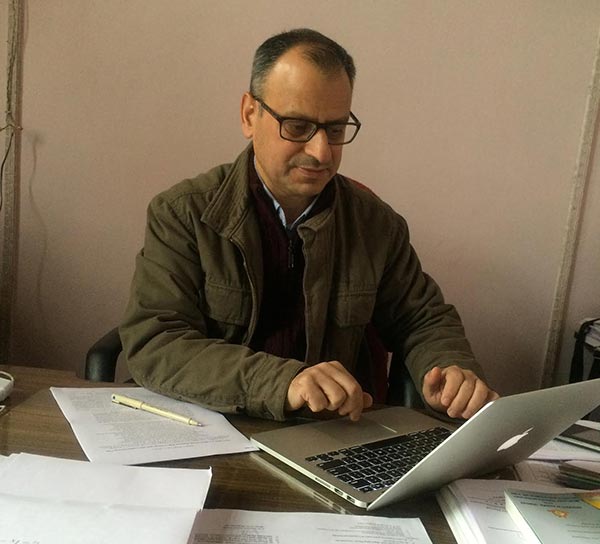From his dimly lit office chamber Dr Sheikh Javid has successfully explored the unexplored part of the universe. Saima Bhat talks to the genius physicist whose find earned him a berth at the prestigious American Physical Society

There is something curiously strange about Dr Sheikh Javid Ahmad – a professor in the physics department and dean of research at the University of Kashmir – who loves to bury himself inside his small office cabin and think of a universe beyond an ordinary man’s comprehension. This calm, cold and dimly lit cabin is like an alternative world for Dr Javid, from where he tries to peep beyond the already explored four per cent of the universe. “About 96 per cent of our universe, which is made up of dark matter/energy, is yet to be explored. Rest four per cent is what we know as of now. And it is this four per cent that is visible to us,” says Dr Javid, who has published more than 126 research articles in international journals.
But it is Dr Javid’s valuable contribution to the ‘study of nuclei beyond the valley of stability’ that earned him a coveted place in the American Physical Society (APS) in 2015. He is the first Kashmiri to make it to the world’s prestigious list of scientists which has over 60 thousand members, mostly Americans. “It is a great honour for a Kashmiri,” feels Dr Javid, whose stint as a scientist at Oak Ridge National Laboratory (USA) and Technical University Munich (Germany), was the reason for his entry into the prestigious list.
Dr Javid is the part of global scientists team who are trying to construct the universe starting with the nucleus itself. Dr Javid’s work has given a new direction to nuclear physics research, as several hundred papers have been written based on his original work.
Interested in studying the basic constituents of a nucleus, Dr Javid says the researchers don’t have a complete understanding of what happens inside a nucleus. “But they probe to study it under different conditions of temperatures and energies and then use a theoretical model and predict the properties of a nucleus,” says Dr Javid.
Theoretical work is also done using models and interactions which are then correlated as the interactions of these elements are not known. For this, models are constructed and then properties are calculated. Properties are also measured by experimental measurements, compared to the study of the interactions agree with the experimental findings.
So far only 250 stable nuclei are well researched. “We don’t have any idea of the properties for the rest of around 3000 unstable nuclei,” claims Dr Javid. “So far we have been able to study them using the available conventional facilities.”
Dr Javid is hopeful that in the next five years they will be able to study remaining stable nuclei as Michigan State University is coming up with new facilities. “With the help of fusion kind of reaction we can construct nuclei only up to Iron (56). Beyond that, we don’t know how elements have been created. We have been using Rapid Proton Capture (RPC) process to study unstable nuclei/isotopes in nuclear physics,” says Dr Javid.
But as they move forward for heavier elements like Lead and Uranium, it changes.
Dr Javid loves to talk about his work on the nuclei of an atom. While studying the properties of gaseous state elements on magical numbers, which are supposed to be somewhat stable and don’t change, Dr Javid proved that they too change. It was a big find that made APS choose Dr Javid, a resident of south Kashmir’s Islamabad district, as a fellow.
Among a list of awards and accolades, Dr Javid was offered a fellowship by the New York Academy of Sciences.
Dr Javid’s journey into the world of physics began after he completed his master’s (1982), and went on to do his PhD from the Indian Institute of Technology (IIT), Bombay (1987). “The next stop was Daresbury Laboratory in England. I did my post-doctoral studies from there.”
After coming back, he started working at IIT Bombay. Then in 1996 he left Bombay and taught in universities in countries like Sweden, Germany, USA and England. “But I always dreamt of coming back to Kashmir,” says Dr Javid. Finally, in 2003, he joined Kashmir University as a professor in physics.
However, his knowledge has made him a sought-after name in physics, as he is a visiting faculty for 14 universities across the world. “We live in a globalised world. I just need a laptop to do my work,” says Dr Javid with a smile.















